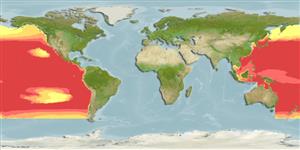Environment: milieu / climate zone / depth range / distribution range
Ecologia
marinhas; estuarina; oceanódromo (Ref. 51243); intervalo de profundidade 1 - 550 m (Ref. 58302). Subtropical; 61°N - 52°S, 99°E - 70°W
North Pacific: Gulf of Alaska to southern California and Baja California and from Sakhalin Island in the southern Sea of Okhotsk south to northern Philippines. There are four substantiated records of this subspecies in the southern hemisphere: off Western Australia, southeast Pacific (37°11'S, 114°41'W) and Gulf of Papua (Ref. 10997). The species occurs mainly in the northern Pacific but ventures into New Zealand waters for at least three months during spring and early summer (Ref. 83312).
Tamanho / Peso / Idade
Maturity: Lm ? range ? - ? cm
Max length : 300 cm FL macho/indeterminado; (Ref. 9340); common length : 200 cm FL macho/indeterminado; (Ref. 9340); peso máx. publicado: 450.0 kg (Ref. 47525); idade máx. registrada: 15 anos (Ref. 83312)
Descrição suscinta
Chaves de identificação | Morfologia | Morfometria
Mean number of gill rakers 35.9. First ventrally directed parapophysis on vertebra number 8. Dorsal wall of body cavity has a narrow bulge with lateral concavity and wide lateral trough. Caudal keels dark.
Epipelagic, usually oceanic, but seasonally coming close to shore (Ref. 168). Tolerates ample temperature intervals (Ref. 168). Forms schools by size, sometimes with other scombrids (Ref. 168). Migrates between June and September in a northward direction along the coast of Baja California, Mexico and California (Ref. 168). A voracious predator that feeds on a wide variety of small schooling fishes and squids, also on crabs crabs and to a lesser degree on sessile organisms (Ref. 168). Marketed fresh and frozen.
Collette, B.B., 1995. Scombridae. Atunes, bacoretas, bonitos, caballas, estorninos, melva, etc. p. 1521-1543. In W. Fischer, F. Krupp, W. Schneider, C. Sommer, K.E. Carpenter and V. Niem (eds.) Guia FAO para Identification de Especies para lo Fines de la Pesca. Pacifico Centro-Oriental. 3 Vols. FAO, Rome. (Ref. 9340)
Status na Lista Vermelha da UICN (Ref. 130435)
Ameaça para os humanos
Harmless
Uso pelos humanos
Pescarias: altamente comercial; Aquacultura: espécies comerciais; peixe esportivo: sim
Ferramentas
Relatórios especiais
Baixar XML
Fontes da internet
Estimates based on models
Preferred temperature (Ref.
123201): 13.9 - 28.1, mean 24.3 °C (based on 983 cells).
Índice de diversidade filogenética (Ref.
82804): PD
50 = 0.5039 [Uniqueness, from 0.5 = low to 2.0 = high].
Bayesian length-weight: a=0.01380 (0.00638 - 0.02986), b=3.03 (2.86 - 3.20), in cm total length, based on LWR estimates for this Genus-body shape (Ref.
93245).
Nível Trófico (Ref.
69278): 4.5 ±0.3 se; based on size and trophs of closest relatives
Generation time: 10.6 ( na - na) years. Estimated as median ln(3)/K based on 2
growth studies.
Resiliência (Ref.
120179): médio(a), tempo mínimo de duplicação da população 1,4 - 4,4 anos (tm=3-5; tmax=15; K=0.1-0.2).
Prior r = 0.25, 95% CL = 0.17 - 0.38, Based on 3 full stock assessments.
Fishing Vulnerability (Ref.
59153): Very high vulnerability (76 of 100).
Climate Vulnerability (Ref.
125649): Moderate vulnerability (38 of 100).
Nutrients (Ref.
124155): Calcium = 18.3 [10.0, 32.3] mg/100g; Iron = 2.32 [0.96, 5.79] mg/100g; Protein = 24.2 [22.7, 25.5] %; Omega3 = 0.403 [0.246, 0.662] g/100g; Selenium = 42.6 [16.1, 118.0] μg/100g; VitaminA = 21.5 [2.9, 199.3] μg/100g; Zinc = 0.355 [0.211, 0.717] mg/100g (wet weight); based on
nutrient studies.
